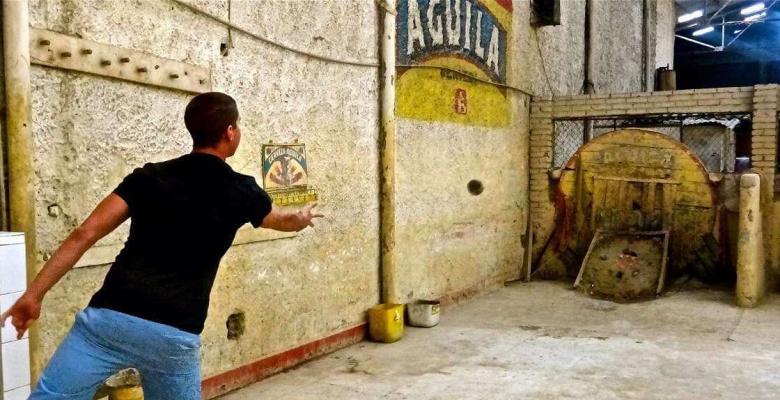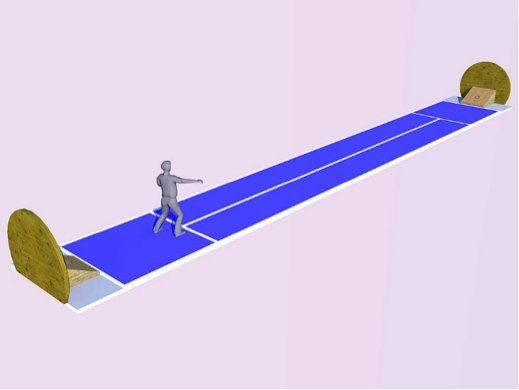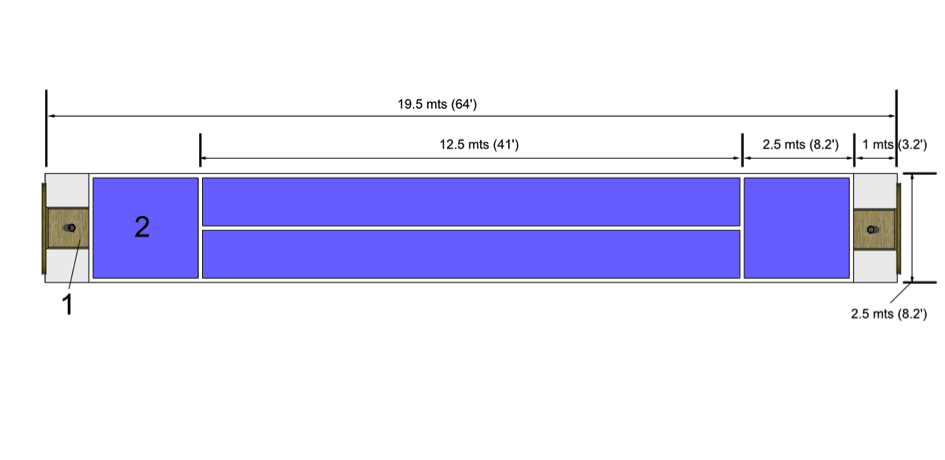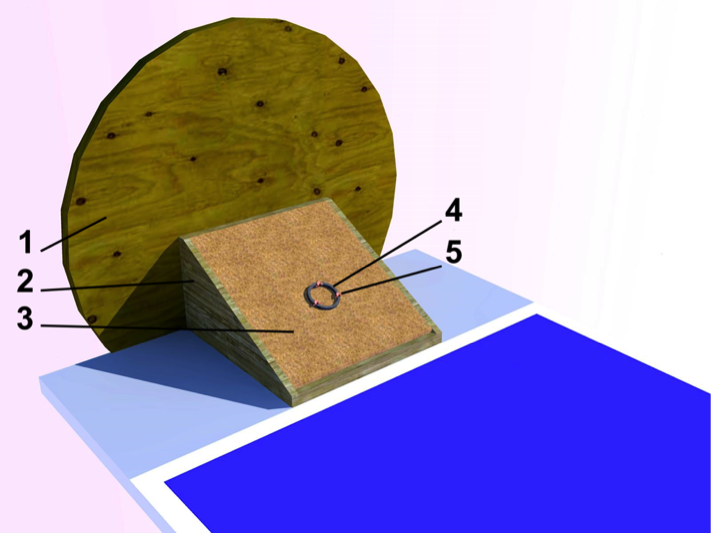
Tejo (Colombia)
- Name of sport (game): Tejo, Turmeque
- Name in native language: Tejo, Turmeque
- Place of practice (continent, state, nation):
Columbia, also Venezuela, Ecuador, Panama
- History:
There are a lot of theories about the origin of this sport. It is widely known, however, that it was practiced by the indigenous population of the central part of Colombia.
Officially in Colombia, it is assumed that the sport was created about 500 years ago. And the indigenous people of Colombia used a gold disc called zepguagoscua, although the researchers claim that the word (or, in fact, sound, pronunciation) did not exist in the Muisca dictionary.
In the Muisca culture (Spanish: Chibcha-Muisca), the Indians in Turmequé, in the region of today's departments of Cundinamarca and Boyac, played the game, which is the original version of today's Tejo. Then that weight was called Zepguagoscua and was made of gold. With time, Tejo started to be made of stone, and nowadays metal is used.
Tejo is practiced broadly by the society. Although there are Tejo arenas for competition at a higher level, sport is above all popular and is seen as part of the pre-Columbian culture of these areas. Only football is more popular. - Description:
The players throw a round weight in a blackboard filled with clay, trying to hit one of the pink triangles filled with gunpowder. If the weight hits, there is a bang due to the explosion of gunpowder. When playing in Cancha de tejo the player should be careful as he is constantly passing other players in Tejo.

Fig. Player's position during the throw
Accessories for playing in Tejo:
- Tejo – a round metal weight, about 680 grams
- a wooden board with a height of 1.5 meters and approx. 90 centimeters–1 meter wide, filled with clay, set aslant to the player at an angle of 35-45 degrees; clay has an intermediate consistency between mud and modeline, which is important, because from it depends the ease of removing Tejo
- Protective board – to prevent Tejo from falling out of the target area
- Bocin – a thin metal cylinder with a diameter of 11 centimeters, two centimeters long, pressed in clay in the middle of the array
- Mecha – gunpowder packed in pink paper in the shape of a triangle; four pieces are put on the edges of Bocin clay (opposite to each other, on four sides),
- L-shaped metal handle for tearing Tejo of clay
- A piece of material made from Fique – for cleaning Tejo of clay
- Cancha de tejo – building with areas to play in Tejo, usually there is also a bar with snacks and beer
- a playing field – 2.5 meters wide, 19.5 meters long (the distance of the player from the board is 12.5 meters) is the size of the field during the competition, but in a recreation game fields may be smaller
- something to write down points
Fig. Size of the field in meters and in feet
In Tejo you can play in an informal or formal manner, to collect points or as a championship rank competition.
Punctation:
Players throw their Tejo in the board. After the throws, the points are counted (though the score can be arbitrary, most often the following chart applies):
- 1 point (mano; hand) – receives the group that Tejo landed the closest to Bocin
- 3 points (mecha; hit) – receives the player who hit the Mecha triangle and caused an explosion
- 6 points (embocinada, bullseye) – receives a group, which Tejo fell into the middle of the board inside Bocin
- 9 points (mañona; strike) – the highest score is awarded to the person who will hit the middle of the Bocin cylinder, after causing the explosion in the previous throw (Tejo breaks down Mecha and hits the middle of Bocin)
Fig. Target system: 1. Protective board, 2. Frame, 3. Clay, 4. Bocin, 5. Mecha
- Current status:
In the year 2000, the Colombian Congress decided to take over the patronage of Tejo and to announce it as a national sport. The National Tejo Federation was established and national competitions are currently taking place. This sport is also practiced in Venezuela, Panama and Ecuador. Because there are no such strong cultural correlations as in Colombia, in other countries it is not so popular.
There are many professional Tejo teams in Colombia, especially in big cities, which are usually sponsored by beer producers. Beer is mandatory for the game in Tejo, although once an alcoholic drink, accompanying players, was Chicha – a local alcohol based on corn.
Nowadays Tejo competition is a professionally organized tournament, usually sponsored by beer producers and construction companies. Tournaments, called "Torneos Relampago" take place over the weekend, and the prizes are medals, cups, money and often home appliances. These tournaments do not arouse special media interest, but are willingly sponsored, as the sport is popular and many people participate in these competitions.
Many people in Colombia opposed to combining this sport with beer consumption, an initiative has even been created to prohibit sponsorship by brewers and alcohol consumption during the competition. - Contacts:
Federacion Colombiana de Tejo: https://www.facebook.com/TejoColombia/
Federacion Colombiana de Tejo Fedetejo (FEDETEJO): https://plus.google.com/106848627230708805873
Club Social y Deportivo de Tejo el Porvenir del Norte: http://clubdetejoelporvenirdelnorte.com/766459_El-Porvenir-del-Norte.html - Sources of information :
https://tysiacodcienizieleni.blogspot.com/2011/08/tejo-narodowy-sport-kolumbii.html
History of Tejo: http://www.boyacacultural.com/turmeque/tejohisto.php
Tejo game: https://www.youtube.com/watch?v=iqKzt0XbWQk
Articles about Tejo: https://explorepartsunknown.com/colombia/tejo-sports/
Article and film about Tejo: http://medellinliving.com/playing-tejo-colombian-sport/
Films about Tejo: https://theculturetrip.com/south-america/colombia/articles/tejo-colombias-national-sport/Source of photos used in this article:
https://travelislife.org/tejo-national-sport-of-colombia/
https://www.colture.co/bogota/tejo/
https://theculturetrip.com/south-america/colombia/articles/tejo-colombias-national-sport/
https://www.trigtent.com/world/colombias-beer-soaked-national-sport-may-have-sober-grow
https://medellinguru.com/tejo/
https://edition.cnn.com/travel/article/tejo-colombia-national-sport/index.html
https://triptins.com/tejo-in-bogota-colombia/
https://shophu.kingsgu.ru/category?name=tejo%20game
https://www.oneseedexpeditions.com/blog/playing-tejo-in-colombia-the-subtle-art-of-throwing-rocks-at-gunpowder
https://floratheexplorer.com/tejo-colombia-national-sport/
https://latinamericanpost.com/15441-tejo-colombia-s-ancestral-sport
https://menway.interia.pl/styl-zycia/po-godzinach/news-tejo-eksplozje-piwo-i-swietna-zabawa,nId,1069888 - Gallery:

